Are you looking for convenient thermometers that accurately measure your oven’s temperature? These specific thermometers are all essential to assess if the temperature your oven produces is adequate for the food you are heating. Otherwise, it would be a shame if your muffins become overheated. And instead of getting a delectable snack, you will be given a burnt mess.
This article will present the best oven thermometers you can get online before you start baking and roasting. We will also give you some tips, such as the optimal oven temperature settings for everyday dishes and the very small amount of maintenance you can provide to your oven thermometer to ensure it is still serving your kitchen correctly.
| OVEN THERMOMETER | BRAND | OUR RATING | CHECK PRICE |
|---|---|---|---|
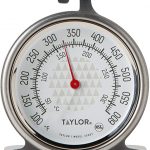 | Taylor Precision Large Dial | Check Price | |
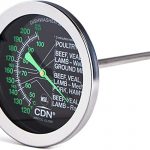 | CDN IRM200-GLOW ProAccurate | Check Price | |
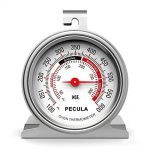 | PECULA Instant Read | Check Price |
~TOP 3 BEST OVEN THERMOMETERS~
Taylor Precision Large Dial

A precise and accurate oven thermometer with a large dial can be easily observed from a respectable distance. It is durable thanks to its relatively larger size and can last longer as long as it is consistently calibrated to ensure it is still properly functioning.
Its stainless steel exterior makes it immune to rusting. This is despite all the moisture and humidity happening around your kitchen mixed with the excessive heat brought by your oven. Overall, a good choice for those looking for accuracy, durability, visibility, and a simple design for an oven thermometer.
CDN IRM200-GLOW ProAccurate

A large and aesthetically pleasing oven thermometer by CDN that provides accurate and helpful measurements. It features a glow-in-the-dark dial that can illuminate in the darkest places, which can be convenient when your oven is placed in a poorly lit room.
Its lens is waterproof and durable, allowing it to survive common kitchen disasters such as spilling water or accidentally dropping the thermometer because your hand was slippery from handling ingredients. This thermometer also has a guide for standard temperatures for common meals that can be very useful in case you forget how much heat poultry would need.
PECULA Instant Read
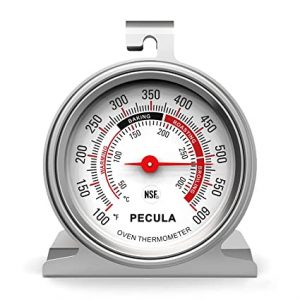
A simple yet convenient and effective oven thermometer by PECULA has a helpful panel and hook design. This oven thermometer provides a clear reading that is visible thanks to its thin yet brightly colored dial and a bunch of color-coded temperature levels.
The temperature range for this thermometer is also vast, ranging from 100 to 600°F, which can be useful when reaching oven processes that require around 500°, such as broiling. Need an oven thermometer that is easy to clean? This thermometer got you covered thanks to its stainless steel exterior. Overall, an outstanding option for those looking for an oven thermometer with a simple design and a useful hook.
~OVEN TEMPERATURE FOR COMMON DISHES~
Making a dish can be a frustrating experience, only to turn out dry and hard instead of soft and juicy. Luckily, there is an easy way to find the right oven temperature for every dish on your list: just consult this handy guide!
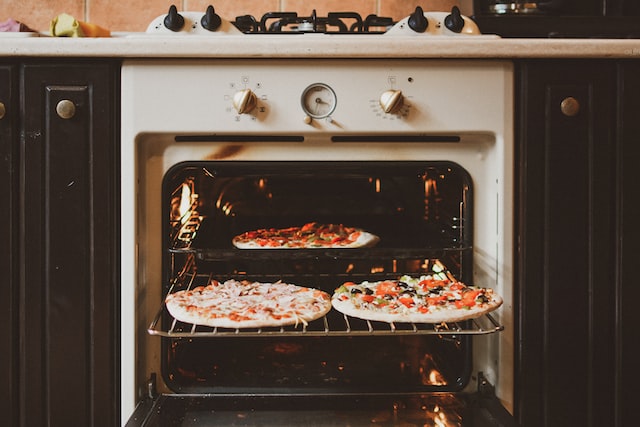
💠 Baking or roasting
Baking is cooking with dry heat, while roasting involves browning or searing. Baking is usually done for bread (or pastries) and cakes, while you can do roasting if you have meats and veggies for your meal.
Cookies and muffins are made in a skillet on top of the stovetop over medium-low heat. Chicken and turkey should be cooked in an oven preheated to 425°F (220°C), then removed from the oven before it reaches 165°F (75°C).
>>350°F (177°C): Baked fruit, roasted vegetables
You may be familiar with the oven temperature of 350°F (177°C). This is the temperature at which food is baked and can also be used to roast vegetables or other foods. The higher the number on your oven’s dial, the hotter your dish will become; however, there are some caveats:
- If you’ve ever attempted to bake bread in a conventional oven that runs at 400°F (204°C), you know how frustratingly slow things go when you’re trying to brown your dough before putting it into an already-hot baking pan. That’s why many home cooks prefer to use convection ovens instead. They heat up more quickly and evenly than regular ones!
- The best thing about using convection mode is that no matter what cooking surface you have, from stovetop burners up to microwave ovens, it’ll work well with even large cuts of meat like steaks or roasts without overcooking them too much during their cooking period.
>>375°F (190°C): Roast chicken or pork tenderloin
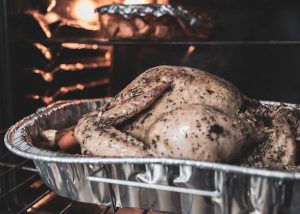
If you’re looking for a lean, flavorful cut of meat that won’t break the bank and can be prepared in the oven, pork tenderloin is a great choice. It’s also ideal for roasting. This is because pork tenderloin cooks quickly and doesn’t require much concentration.
Pork tenderloin is often served with a coating of herbs and spices such as garlic powder, thyme, or rosemary (or all three); however, you don’t need too many ingredients to make this dish stand out from others on your plate! Simply season each slice with salt and pepper before throwing them into an oven at 375°F (190°C) until they’re ready—about 15 minutes per side should do the trick.
>>400°F (200°C): Crispy-skinned chicken or roast turkey
400°F (200°C) is the perfect temperature for roasting, crisping skin, and cooking meat. This is also the optimal temperature if you’re cooking turkey or chicken.
400°F (200°C) is what your oven should be set at when searing fish in olive oil or making a sweet potato pie with brown sugar.
>>425°F (218°C): Roasted chicken wings, breaded oven-fried chicken tenders, or fish sticks
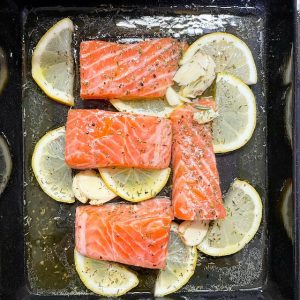
If you want to ensure that the chicken is cooked evenly and doesn’t end up overcooked, use a meat thermometer. Insert the probe into the stale part of each chicken piece and check for an inner temperature. It must reach up to 165 degrees F (75 degrees C).
>>450°F (232°C): Dinner rolls, crescent rolls, pizza crust, muffins, and sweet bread.
For dinner rolls and other food that needs re-heating, it is advisable that you set it around 450°F. This is to make the most out of its remaining flavor.
💠 Broiling
Broiling is a dry cooking method that uses direct radiant heat. It’s similar to grilling, except the food is cooked on a broiler pan, not on a grill rack. The broiler pan is placed under the oven’s heating element and can be combined with other processes such as baking or roasting.
It is also a speedy, high-heat method of cooking that brings out the best in meats, fish, and poultry. It’s ideal for open-faced sandwiches and cheese on bread. 500°F (260°C) broil meats, fish and poultry, open-faced sandwiches, and cheese on bread. Most of the broilers in the market have two settings: choose from low and high. Set the oven rack 6 to 8 inches from the heat source.
>>There is a charming spot for every dish.
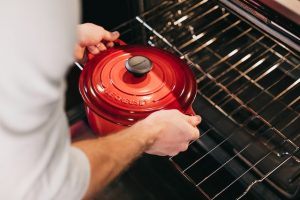
For example, if you’re cooking a steak on the grill and want it to be perfectly medium-rare, then you will want your oven temperature to be around 400 degrees Fahrenheit (204 Celsius). But if you were baking cookies in the oven and wanted them to come out right—soft but not too gooey or hard—then your target temperature would be about 350 degrees Fahrenheit (177 Celsius).
The sweet spot for most baked goods is around 325 degrees F (163 C). If you don’t have an accurate thermometer or know what type of pan you’re using with each recipe, use these guidelines as general rules of thumb.
~CALIBRATION~
Calibration and replacement are important for oven thermometers to ensure they are still accurate enough for regular usage. You can follow our steps below to complete these methods:
💠 Simple calibration process
The simple calibration process is as follows:
- Boil water or ice water in an appropriate vessel.
- Place your oven thermometer in the boiling or freezing liquid and wait for it to reach a temperature of 212 degrees Fahrenheit or an equivalent of 100 degrees Celsius.
- Once you’ve reached this point, remove your thermometer from the boiling/freezing liquid and place it on a black surface that can be placed in direct sunlight (such as a black candle). Place it there for half an hour before taking its reading again. If necessary, repeat this process until you have reached consistent readings across all temperatures tested by your instrument model. This should take only one round of calibrating!
💠 When to calibrate
To keep your oven thermometer in working order, you must calibrate it every three months. Here’s how:
- Turn off all power to the oven and unplug it from its power source (if it has one).
- Place a clean towel under the bottom of your electric model. Then, place another towel on top of that one to prevent any spills or messes from getting into cracks in your electric model’s baking chamber or door hinge pieces during calibration testing procedures.
If the calibration results seem off and different than usual, you should most likely replace your oven temperature. The inaccuracies will be much more common in your thermometer than in your oven.
~OVEN SAFETY USING THERMOMETER~
What’s the best way to make sure that your oven is safe? A properly working thermometer is essential to ensuring safety and checking your oven’s effectiveness.
How often should you change or calibrate an oven thermometer? If it’s not broken, you can leave it alone for a few months before needing to replace it again. However, if you encounter issues with your new thermometers, such as accuracy or temperature readings, we recommend that one be replaced immediately!
~IMPORTANCE OF THERMOMETER~
However, you must replace or calibrate the unit after a certain period. An oven thermometer is a device that measures the temperature inside your oven. The most important thing to know about an oven thermometer is that it should be calibrated regularly for you to avoid any accidents due to inaccurate readings.
Suppose you don’t calibrate your oven thermometer. In that case, you have no idea how hot or cold something is cooking at any given time. And this could lead to serious injury or death if someone were to eat something made with these incorrect temperatures.
~BOTTOM LINE~
Oven thermometers are one of the necessary tools in the kitchen. This is to accurately measure the appropriate amount of heat that should be placed on your meal. Applying too little or too much heat can be detrimental to your food and your appetite. Of course, there is an affordable and quick fix to this. This is to pick one of the best oven thermometers on our list. Hopefully, they can serve you well the next time you start broiling meat!
If your oven is producing too much heat, then you can destroy your kitchen, including the countertop. Click here to know more about safe and low-maintenance countertops.
